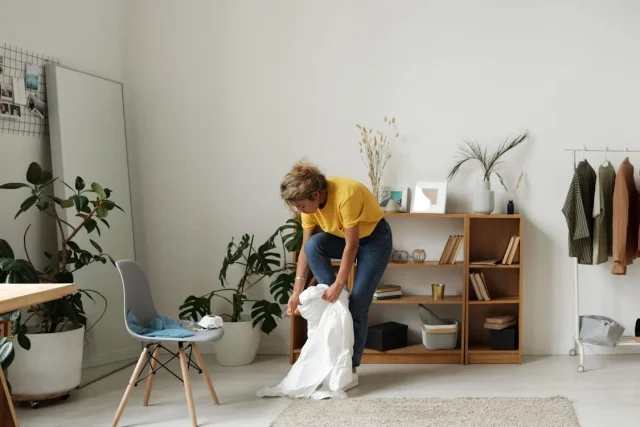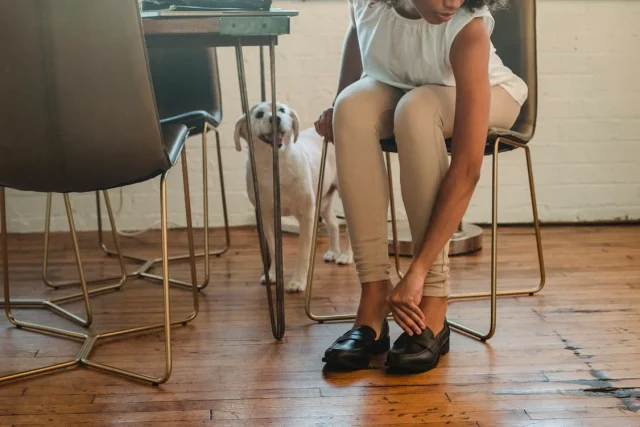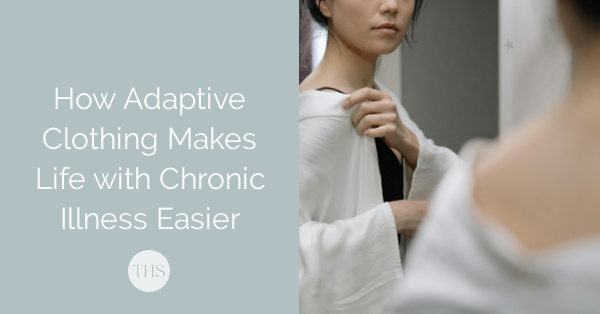9 Tips for Writing a Daily Plan for People with Chronic Diseases

Living with chronic illness presents various challenges in your daily life. Even a simple daily activity like getting dressed becomes a daunting task when your arthritic fingers can’t button up a shirt or your limited mobility stops you from getting a sweater over your head. Regular clothing also isn’t always a good fit for people who wear colostomy bags or oxygen lines, or who sit in a wheelchair all day.
As the fashion industry becomes more open and inclusive, the rise of adaptive clothing has made life easier for people with disabilities. Adaptive clothing has become a solution to this problem, offering comfort as well as independence to those struggling with these illnesses.
Adaptive clothing has emerged as a solution that incorporates fashion and comfort to enhance the quality of life by addressing the needs of individuals with chronic illnesses and disabilities.
To truly appreciate the impact of adaptive clothing, it is essential to dive deeper into its features, benefits, and innovative approaches that make it a game-changer in the world of fashion, adding functionality for people with special needs.
Adaptive clothing is designed to accommodate the special needs of people with chronic illnesses and disabilities. It is gaining attention because it has significantly improved people’s lives, making their daily dressing activities easier.
Specialized garments are designed to address unique challenges faced by people with physical limitations, providing practical solutions with simple modifications. They can also be said to add body positivity and make you feel more comfortable. Unlike traditional garments, these clothes adapt features that make dressing every day easier and more comfortable.
Adaptive clothing comes in a variety of styles, from casual to formal, so that people with chronic illness and disabilities can feel confident in their clothing. Features include easy-access fastenings, adjustable closures, and soft, non-irritable fabrics.
Adaptive garments are also easy to wear and don’t require any strength, making dressing simple for people with disabilities, too, like it is for people without disabilities. For someone with limited mobility or skin sensitivities, these modifications make effective differences.

Dressing poses numerous challenges for individuals with limited mobility caused by chronic illness, disabilities, or age-related conditions. Such conditions complicate actions such as bending, standing, lifting arms, and tying shoelaces, making the basic task of dressing overwhelming without help. Here are some examples of how these challenges of clothing can manifest in day-to-day life for people with reduced dexterity:
Arthritis can cause severe joint pain and swelling. For individuals with arthritis in their hands, manipulating buttons, zippers, or hooks can be extremely painful. Likewise, arthritis in the legs can make individuals struggle with putting on pants due to painful inflammation in the joints, ligaments, or tendons. Selecting loose-fitting attire featuring stretchable fabric and elastic waistbands makes a big difference in mitigating the dressing challenges.
Due to decreased flexibility and strength, elderly individuals with mobility issues find it challenging to bend down to put on shoes or trousers or to manipulate shirt buttons. Even the basic act of putting on pull-over shirts or pants with elastic may become tiring. For such individuals, comfortable clothing such as front-opening shirts with zippers, pants without tight elastic bands, or shoes with Velcro fastenings make dressing more convenient.
Parkinson’s disease greatly affects movement, causing uncontrollable tremors, stiffness, postural imbalance, and involuntary motion. Individuals who experience severe tremors find it difficult to wear clothes with buttons, zippers, or tie shoelaces. Those experiencing issues with balance and coordination are often at risk of falling while dressing. Selecting simple attire like cardigans, loose pull-over t-shirts or sweaters, wrap-around skirts, and elastic waistband pants makes dressing manageable.

Adaptive clothing for disabled people is created based on their requirements. Different types of modifications are made according to their needs. For instance, magnetic closures are used instead of buttons or zippers for people with physical disabilities, while longer back panels are created than shorter ones for people in wheelchairs.
Here is how different features make clothing easier for people with different disabilities.
One of the primary benefits of adaptive clothing is the ease it brings to the dressing process. Adaptive clothing for disabled people includes magnetic closures, Velcro fastenings, elastic waistbands, and other features that require less strength to get dressed. These features are particularly beneficial for people with disabilities in hand movement or chronic illnesses that cause pain.
Adaptive clothing also includes pants and tops with side zippers that provide wider openings for dressing. The shoes are also easier to pull and have elastic laces that don’t compromise fashion while providing comfort. These features also mean that dressing can be done with minimal assistance, encouraging self-sufficiency.
Adaptive clothes for disabled people are crafted from soft, breathable fabrics that reduce the risks of skin irritation and pressure sores. This is beneficial for people with sensory issues, as harsh fabric can cause irritation and may be uncomfortable.
Adaptive clothing also allows easy access to prosthetic limbs, making them safe and functional for use. It also uses durable fabrics to withstand the friction and wear associated with prosthetic users.
Additionally, to make clothes safe for wheelchair users, adaptive clothing for disabled people has shorter front panels than the back. It also has adjustable hems to avoid tripping on wheelchair wheels and side zippers to take off a part of pants or tops without having to take off the whole garment.
More than meeting individuals’ functional needs, adaptive clothing also encourages self-dependency and makes people with disabilities feel more confident. The integration of fashion and ease ensures that wearers can maintain their dignity and feel comfortable without compromising fashion.
Fashion is all about self-expression for many people, and adaptive clothing for the disabled allows them to express themselves through fashion. This focus on style, along with independence in dressing, is vital as it enhances self-esteem in individuals with disabilities.

One of the leading brands in adaptive clothing for the disabled is Tommy Hilfiger. This professional brand offers a wide range of options for men, women, and children. Tommy has crafted many clothing pieces for individuals without compromising fashion.
Hilfiger has innovative designs like magnetic buttons, one-handed zippers, and adjustable hems, but it is crafted keeping fashion and style in mind. For example, they have a shirt with traditional sewn-on buttons, but there are hidden magnetic clasps for easily putting it on and taking it off.
Tommy Hilfiger Adaptive is one of the most liked brands because of its inclusivity in fashion while making it accessible and functional.
Zappos Adaptive is an innovative brand that customizes clothes according to your needs. It offers clothes for men, women, and children. Zappos has been diligently working to be more inclusive in the true sense, considering all kinds of disabilities.
For instance, Zappos can provide different-size shoes if an individual has orthotics. They also have comfortable, light fabrics for people with sensory issues. Zappos is an innovative brand, and it has you covered if you are looking for adaptive clothing that is comfortable, functional, and stylish.
Billy Footwear is a brand of adaptive sneakers. It was founded by a disabled individual who was in search of attractive yet accessible sneakers. With Billy Footwear, you can expect functionality and style.
They come in different colors and designs for men, women, and children. The sneakers have zippers all the way to the front, so you can wear them without having to slide your food into them.
Popular brand JanSport also has its adaptive collection. JanSport has created bags for people with special needs. Traditional bags do not stay secure on the back of a wheelchair and risk falling off, so JanSport has designed backpacks and bags for use with wheelchairs and walkers.
These bags are easily accessible, stay secure, and look stylish. They resemble classic JanSport bags with adaptive features like anchor straps and several compartments for easy access to your items.

In conclusion, the fashion industry is transforming significantly, providing options for everyone. Adaptive clothing is emerging, providing individuals with disabilities and chronic illnesses a seamless blend of style, comfort, and functionality.
Leading brands like Tommy Hilfiger and JanSport are also promoting adaptive clothing, ensuring that everyone, regardless of physical ability, can enjoy fashionable and practical clothing. As awareness and demand continue to rise, we can expect more advancements and diversity in adaptive clothing options, further enhancing the quality of life for those who rely on these thoughtful designs.
Author bio: is an experienced writer with a diverse portfolio spanning from health and wellness to tourism and hospitality. Her writing features intriguing narration with a blend of factual accuracy, depth, and clarity. With an academic background in English and Psychology, she has contributed to numerous reputable publications, showcasing her passion for writing.
For more practical tips on how to make daily life with chronic illness easier, check out 17 Practical Tips to Simplify Self-Care, Chores and Life Admin and Beyond Bubble Baths: What Self-Care Really Means When You’re Chronically Ill.